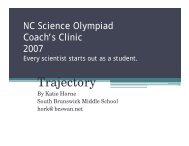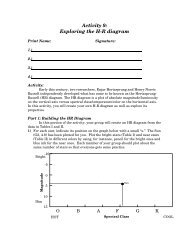Super Sleuths 2014 rules
Super Sleuths 2014 rules
Super Sleuths 2014 rules
You also want an ePaper? Increase the reach of your titles
YUMPU automatically turns print PDFs into web optimized ePapers that Google loves.
<strong>2014</strong> NCSO It’s Elementary Manual ©<strong>2014</strong> NCSO <strong>Super</strong> <strong>Sleuths</strong>Revised 10/15/2013*1. DESCRIPTION: Given a scenario and possible suspects, teams will perform a series of physical andchemical tests. These test results, along with other descriptive evidence, will be used to solve a crime andname the perpetrator.2. ESSENTIAL STANDARDS ALIGNMENT: 3.P.2, 4.P.2, Science as Inquiry3. TEAM OF UP TO: 24. MAXIMUM TIME: 60 min.5. TEAMS: Teams may bring only specified items and goggles. No other items are allowed. The eventsupervisors will check the kits, and confiscate non-allowed items. Students not bringing these itemswill be at a disadvantage.1. Spot plates, paper cups, or any containers in which teams can perform the tests2. Droppers, popsicle sticks, spatulas, plastic spoons, tongs, and/or forceps for handlingmaterials3. pH test strips or paper4. A ruler5. A wash bottle or dropper bottle of distilled water6. Hand lenses or loupes7. Paper towels8. A disposable cup for solid waste9. Writing instruments10. Safety gear – see rule #7.6. EVENT LEADERS: Event leaders will provide evidence at a central location or pre-organized bags orpackets of evidence for each team along with the following:a. Iodine reagentb. Vinegarc. Isopropyl (rubbing) alcohold. A waste containerThe event leader may provide additional equipment such as microscopes or special demos as the testcalls for, instructions on additional equipment will be given if deemed necessary. Flame tests are notpermitted.7. SAFETY REQUIREMENTS:Students must wear the following or they cannot participate:a. Closed-toed shoesb. Safety gogglesc. Long hair must be tied backd. Optional: aprons, gloves, and lab coatsStudents who unsafely remove their safety goggles or are observed handling any of the material orequipment in a hazardous/unsafe manner (e.g., tasting or touching chemicals or flushing solids down adrain) will be disqualified from the event.8. IMPOUND: No33
<strong>2014</strong> NCSO It’s Elementary Manual ©<strong>2014</strong> NCSO 9. THE COMPETITION: Teams will be given a scenario that introduces a crime, suspects, and sourcesof evidence. Teams will perform tests on the evidence to identify the perpetrator of the crime, and writeup their analysis of the crime.a. Crime Scene Chemical Evidence:1. Powders: Teams will be asked to identify no more than 4 of the following: table salt(sodium chloride), baking soda, talc, borax (sodium borate), cornstarch, sugar (crystal),sand, flour, and/or powdered effervescent antacid (i.e. Alka-Seltzer). There will be nomixtures of powders.2. General Knowledge: Teams will be expected to answer questions about the tests theyperform and proper lab procedure. Example questions:i. If the pH of a substance is 3.5, is it acidic or basic?ii. What does it mean if a powder turns black in the presence of iodine?iii. What is the proper method to smell a chemical?b. Crime Scene Physical Evidence:1. Fingerprints. Teams will be asked to compare fingerprint evidence. Teams should be ableto identify the 3 basic types of fingerprints- loops, whorls, and arches, as well as deltasand minutiae.2. Glass: Teams may be asked to determine the type of glass found at a crime scene. Theymay be asked to match glass samples based on observable characteristics such as opacity,texture, thickness, irregularities, etc.c. Analysis of the Crime:Students will answer questions about which pieces of evidence implicate which suspect andwhy the suspect was chosen as the culprit, and also why the other suspects were not chosen.They will also answer any other crime scene analysis questions posed by the event supervisor.10. SCORING: The team with the highest score wins. Time will not be used for scoring. The score will becomposed of the following elements (percentages given are approximate):a. Analysis of chemical evidence 50%, analysis of physical evidence 30%, and analysis of the crime20%.b. Tiebreaker: The highest score on the chemical evidence analysis will break ties.c. A 10% penalty may be given if the area is not cleaned up as designated.11. EVENT RESOURCES:http://www.sciencenc.com/event-help/supersleuths.phphttp://www.sciencenewsforkids.org/2006/04/fingerprint-evidence-3/http://forensics.rice.edu/en/materials/csi_spread%204.pdfhttp://www.glasgowsciencecentre.org/online/forensic-science.htmlhttp://sciencespot.net/Pages/kdzforsci.htmlhttp://www.crimemuseum.org/library/forensics/glassanalysis.html*Numbering was corrected for #s 7 – 11.34




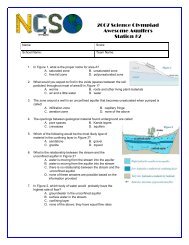
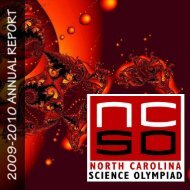

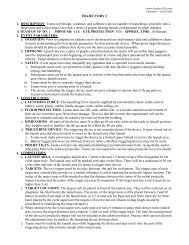
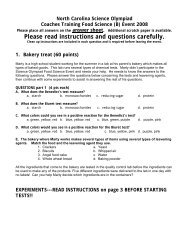
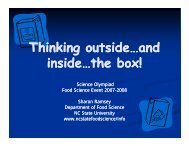
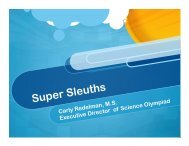
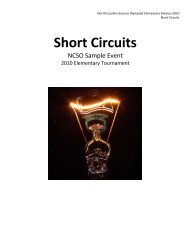
![Shock Value Practice Test[1].pdf - Science Olympiad Student Center](https://img.yumpu.com/42685889/1/190x245/shock-value-practice-test1pdf-science-olympiad-student-center.jpg?quality=85)


